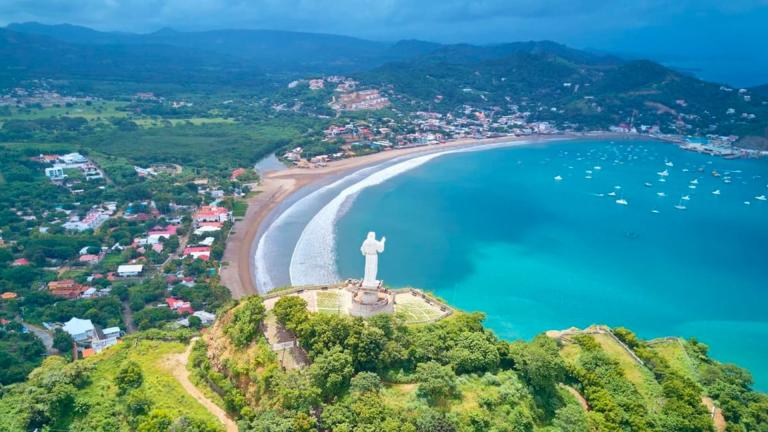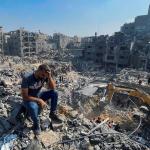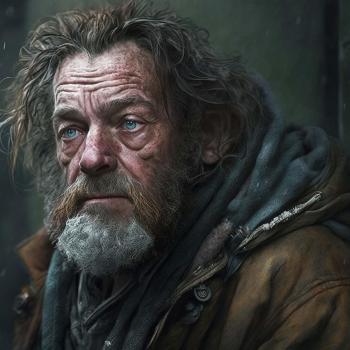
“The biggest problem facing the seven churches [of the book of Revelation] was Babylon. And the biggest problem we still face in our churches today is Babylon” (McKnight, Scot; Matchett, Cody. Revelation, 50).
I recently watched a documentary that described conditions in a country during the 43-year reign of a brutal dictatorship. The narrator begins, “Imagine that you and your family live in one of the poorest regions of the world. . . . And two or three times you watch a family member die from something curable like diarrhea. . . . Hardly anyone [in the country] can read or write. . . . If you are lucky you might get a few months’ work picking cotton or cutting cane for 40 pence a day. . . . And perhaps you wonder why your country produces luxury goods and food for exports to wealthy countries like the US or GB. . . . But if you wonder aloud about this, you put yourself at great risk and you may even end up on a rubbish heap, murdered.”
The documentary then reported that the dictator was toppled (by means of a violent revolution that tragically cost the lives of 50,000 men out of a population of 3 million). After the revolution, it noted that 2,500 new schools were established; illiteracy was lowered to less than 10% of the population; polio was eradicated; infant mortality had been cut by a third; and serious malnutrition was significantly reduced.
This story might make for a great movie. There is a perfect script. Suffering, oppression, and injustice reign because of the rule of an evil dictator. Freedom fighters muster the courage and seize the opportunity to liberate the people. And, although many tragically die in the revolution, the rebels find success. They overthrow the dictator and liberate the people. Finally, the fear of tyranny has been replaced by hope.
Unfortunately, this story has a disheartening twist.
The Great Prostitute (Rev 17:1-19:10)
The book of Revelation’s narrative climaxes in the account of the Bride, the Holy City, the New Jerusalem (Rev 21:1-8; 9-22:9). The Bride is clearly contrasted by John’s description of an audacious prostitute (Rev 17:1-19:10).
NB: See my previous post in which I discuss the Great Prostitute. See also, upcoming episodes of the Determinetruth podcast—beginning Mar 4, 2024—in which we discuss Rev 17-18 and Revelation’s Great Prostitute.
In John’s account, the demise of the Great Prostitute brings lament from the kings of the earth, the merchants, and those who work the seas (Rev 18:9-19)—all of whom profited from Rome’s insatiable appetite for pleasure.
The people of God, however, are exhorted, “Rejoice over her, O heaven, and you saints and apostles and prophets, because God has pronounced judgment for you against her” (Rev 18:20).
As I noted in my last post, the Great Prostitute/Babylon is most certainly Rome—in particular, Rome’s economic and commercial interests. Ancient Rome was littered with opulence. Although today we inexplicably esteem ancient Rome (see last week’s post) and her accomplishments, when John saw the Great Prostitute, he saw oppression and injustice: “And in her was found the blood of prophets and of saints and of all who have been slain on the earth” (Rev 18:24).
What I find intriguing about the book of Revelation’s account of the Great Prostitute is that while most studies focus on her identity, what is rarely discussed is the place where John was taken in his vision in order to see her: “And he carried me away in the Spirit into a wilderness; and I saw a woman . . .” (Rev 17:3).
In the narrative of the book of Revelation, locations matter. This is evidenced by the fact that later (Rev 21:9-22:9) John is shown another woman: “And [he] showed me the holy city, Jerusalem, coming down out of heaven from God” (Rev 21:10). Now, in order to see this woman, John says that he was carried away “in the Spirit to a great and high mountain” (Rev 21:9).
It is important to note that the imagery of a mountain is multifaceted in apocalyptic writings. Since mountains are where the palace for the king, as well as the temple(s) for the gods, were located, “mountains” often serve to represent kings and kingdoms. it stands to reason then that because John is taken to a mountain to see the Bride, this likely indicates that the Bride is a new Kingdom.
The Wilderness
In the account of the Great Prostitute, however, John is taken into the wilderness (Rev 17:3). Though the theme of the “wilderness” is also multifaceted, it is more significant for our sake to note that she is in the wilderness. You see, one of the significant features of the Book of Revelation is John’s careful use of terms and expressions. As I argued extensively in my forthcoming commentary, there is little doubt that John regularly links passages by repeating a keyword or phrase. This is especially the case when the word or phrase occurs in only two or three passages. In other words, there is a good chance (other factors have to be considered of course) that John intends for us to link the two passages.
NB: We discuss this often in our detailed examination of the book of Revelation in the Determinetruth Podcast (available wherever you get your podcasts).
With this in mind, it is interesting to observe that John uses the term “wilderness” (eremos) 3x in the book of Revelation (12:6, 14; and 17:3). The three uses, however, are restricted to only two passages (12:1-17; 17:1-3). The first two uses of “wilderness” (Rev 12:6, 14) both depict the location of the people of God (see brief discussion in my book Follow the Lamb, 60). In other words, the wilderness is where the people of God are. Consequently, it should come as a bit of a shock to learn that the wilderness is also where the Great Prostitute roams.
If John intends for us to conclude that the Great Prostitute is in the wilderness, which is where the people of God (and I think he does), then the message for his readers is that it is not simply a matter of staying away from the Great Prostitute—as if the Great Prostitute was over there. Instead, the people of God need to “resist” because the Great Prostitute is in their midst and she aims to lure them in also.
NB: There is much to say here, but suffice it to note that there are good reasons to link the Great Prostitute with “prophetess” Jezebel who had infiltrated the church in Thyatira (Rev 2:20-22).
Have we been misled?
You see, the country in the opening story is Nicaragua. And the dictator was the American-backed Anastasio Somoza. This is the same S0moza of whom Roosevelt said, “That guy is a Son of a _____ but he is our Son of a _________.”
During his 43-year reign, while the people wallowed in abject poverty, Somoza came to own half of the land and most of the companies in Nicaragua. What is worse is that Somoza’s interests were ruthlessly protected by the national guard: The national guard which was known for torture and killing at will. This is the same national guard that the US created, paid for, and armed as a part of America’s “foreign aid program.” This is the same national guard whom Reagan labeled, “Freedom Fighters.”
And what if I told you that the revolutionaries who ousted Somoza were the Sandinistas? Now, I am not suggesting that the rebels were devoid of corruption. I am not even suggesting that they were not backed by the communists.
My point is that the US armed and funded, with our tax dollars, a brutal dictator who apparently pocketed money (our tax dollars) that was earmarked as foreign aid—which seems to indicate that it was intended to provide relief from disease, food depravation, and the like.
NB: According to the documentary, after the 1972 earthquake in Nicaragua, which killed as many as 10,000, injured another 20,000, and left 300,000 homeless, the US sent $57 million in emergency aid. The IMF gave another $65 million. The national treasury of Nicaragua, under the control of Somoza, however, only reported receiving $16 million. It is alleged that Somoza pocketed upwards of $41million of the US “aid.”
One of the many problems here is that our “aid” did not go to caring for the poor (as the moniker “foreign aid” suggests). Nor were we fighting against oppression. We were, in fact, fighting against the oppressed and all the while arming the oppressor.
We were acting in the interests of American corporations. Such actions, it appears, have been common for many American military endeavors.
American Major General Smedley Butler, in his book War in a Racket, bluntly affirmed,
“I was a racketeer, a gangster for capitalism. I helped make Mexico and especially Tampico safe for American oil interests in 1914. I helped make Haiti and Cuba a decent place for the National City Bank boys to collect revenues in. I helped in the raping of half a dozen Central American republics for the benefit of Wall Street. I helped purify Nicaragua for the International Banking House of Brown Brothers in 1902-1912. I brought light to the Dominican Republic for the American sugar interests in 1916. I helped make Honduras right for the American fruit companies in 1903. In China in 1927 I helped see to it that Standard Oil went on its way unmolested. Looking back on it, I might have given Al Capone a few hints.”
“Ah, but we helped Somoza and the Contras fight against Marxism,” you might retort. The Contras were good because they were fighting the Marxists. I have two things to note in response.
- Somoza was a horrifically corrupt and brutal dictator, who profited greatly from American assistance. He appears to have been responsible for countless atrocities against the people of Nicaragua.
- Regardless of whether or not the Sandinistas were supported by communist regimes, I question whether or not we should encourage our government to fund an evil regime. If the US wants to enter the politics of Nicaragua, or any other country for that matter, it should do so by helping to care for the poor and the oppressed. It appears that we did exactly the opposite. Do we not realize that by actually providing aid and support for the poor and the oppressed we will likely win the approval of those within other nations? Whereas, funding an oppressive regime will in the long run only earn the ill will of the people of those countries.
“Come out of her My people”
This my friends is what the book of Revelation calls the Great Prostitute who sits atop the Beast (Rev 17-18).
What does this mean for us?: “I heard another voice from heaven, saying, “Come out of her, my people, so that you will not participate in her sins and receive of her plagues; for her sins have piled up as high as heaven, and God has remembered her iniquities” (Rev 18:4-5).
In future posts, we can examine what “coming out of Babylon” means.
Our goal is to keep these posts free of charge. I do not intend to ever hide them behind a paywall. I can only do this if those of you who have been blessed by them and can afford to give ($5, $10, $25, or more/month) do so. You can give a tax-deductible contribution by following this link.
Please share this post and let others know about determinetruth.
If you wish to view this blog on your smartphone through the Determinetruth app simply download the “tithe.ly church” app on your smartphone and insert “determinetruth” as the church name you wish to follow. Once it is loaded, simply click on the “blog” icon and it will automatically load.
If you would like to have Rob speak at your church or organization in person or via Zoom, please let us know by filling out the contact info on the Contact me tab on this site.













